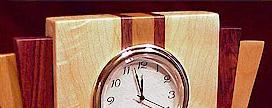This style consists largely of low relief geometrical designs, often
in the form of parallel straight lines, zigzags, chevrons and stylized
floral motifs. The practitioners of the style attempted to describe the
sleekness they thought expressive of the machine age. The growing impact
of the machine can be seen in repeating and overlapping images in streamlined
forms derived from the principles of aerodynamics. Stripped down forms
and geometric-based ornamentation. It is characterized by the use of angular,
symmetrical geometric forms.
Its all based on the elements of design. Notice the straight lines and
the straight sound holes. The simple geometrical shapes and directional.
Another basic shape is the triangle of the rear sound hole. These are
all basic shapes that are used. The wood grain itself is also directional,
its straight and in the same direction of the long neck and the sound
holes. Everything on it has direction and therefore it gives a look that
is streamlined. Streamlining is an important element of Art Deco. It suggests
movement and even speed. The guitar looks like it can fly. It looks like
it may have some jet engines. Most elements are related horizontally in
one direction. The whole thing is a unit.
You will also see repetition. Even the numbers are echoing each other.
The two knobs matched by the two sound holes and two switches. A repetition
in the numbers. Two identical knobs, two identical switches, two identically
shaped sound holes, except for their size. Numbers are being repeated.
However the larger shapes such as the sound holes are repetition with
variation, those being of different sizes. This adds interest. The white
color of the stripe on the top is directional. The swirled grain is also
directional yet the grain adds texture to the otherwise smooth surface.
All the grain is directional. The color of the dots echo the wood of the
top, itís the same wood. The diagonal direction of the dots again repeats
the direction, yet it adds variation because its not straight.
Contrast is also used in the white center of the top, which flows in
nicely with the color and direction of the neck contrasted by the rest
of the body color. Contrast of the Nickel hardware is shiny as compared
to the matte finish of all the wood parts. Black hardware would not have
given its period-correct look. The direction of the pickups are perpendicular
to the horizontal direction of everything else. This ads needed contrast.
The earth tones of the wood color contrast with the shine of the nickel
and the black of the knobs, pickups and tuner knobs. The whole unit is
harmonious in that the colors of the wood are close to each other on the
color wheel. Harmony is also seen in the identical shapes repeated yet
sometimes with variation, slightly different in size. The elements of
texture and direction are also harmonious throughout. Everything was thought
out according to the elements of design and in keeping it historically
correct with the exciting style of Art Deco. This is what makes this work
so much fun and creative.
